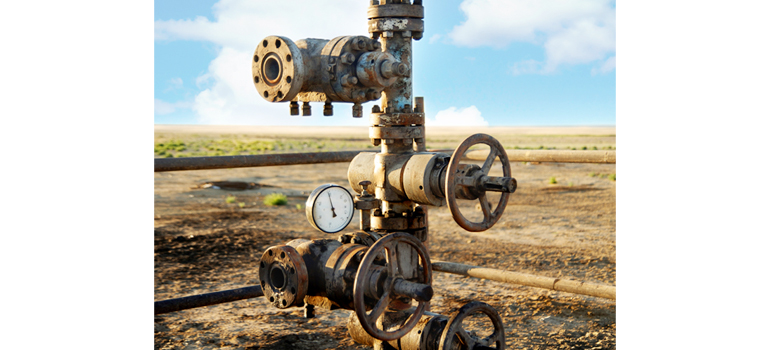
Underground carbon sequestration gets a new improved process from IIT-Madras researchers.
The best way to neutralise carbon dioxide emissions is to bury them underground, preferably in depleted oil and gas reservoirs. Since carbon dioxide also helps by flushing out the oil or gas, these reservoirs are ideal solutions for putting away the mischief-making gas. It is estimated that a barrel of oil when burnt emits 0.4 tonnes of carbon dioxide; correspondingly, 0.3-0.6 tonnes of the gas can be sequestered per barrel extracted – making hydrocarbons carbon-neutral.
All of this has been known for some time, but researchers at IIT-Madras have now come up with some improvements. They have found that supercritical carbon dioxide can be a good agent for simultaneous carbon dioxide sequestration and enhanced oil recovery (EOR) from depleted reservoirs when the gas is used along with surfactants in a ‘surfactant-alternating gas (SAG) injection’ approach. (Above a certain temperature and pressure, carbon dioxide acquires properties that are midway between gas and liquid – denser and easy to pump – known as supercritical state.) In this process, carbon dioxide gas is injected in the reservoir, where it becomes supercritical, followed by injection of water or surfactant solution.
The study shows that the use of supercritical carbon dioxide for EOR resulted in greater storage of carbon dioxide for both water-alternating gas (WAG) and SAG approaches. However, SAG performed better at all pressures and temperatures as surfactant solution alters the interfacial tension between the oil and water phases, leading to a higher oil recovery percentage and more effective storage of carbon dioxide. The researchers also found that the reservoir pressure and temperature had a strong effect on the flow dynamics.
This method not only promises improved recovery of oil but also safe, enhanced, and permanent storage of carbon dioxide gas emitted from human and other anthropological activities, for both WAG and SAG approaches, says Prof Jitendra S Sangwai of IIT-M.
The use of supercritical carbon dioxide reduces oil viscosity, induces in situ swelling of the oil, and reduces the interfacial tension of the in-situ fluid system.
The best way to neutralise carbon dioxide emissions is to bury them underground, preferably in depleted oil and gas reservoirs. Since carbon dioxide also helps by flushing out the oil or gas, these reservoirs are ideal solutions for putting away the mischief-making gas. It is estimated that a barrel of oil when burnt emits 0.4 tonnes of carbon dioxide; correspondingly, 0.3-0.6 tonnes of the gas can be sequestered per barrel extracted – making hydrocarbons carbon-neutral.
All of this has been known for some time, but researchers at IIT-Madras have now come up with some improvements. They have found that supercritical carbon dioxide can be a good agent for simultaneous carbon dioxide sequestration and enhanced oil recovery (EOR) from depleted reservoirs when the gas is used along with surfactants in a ‘surfactant-alternating gas (SAG) injection’ approach. (Above a certain temperature and pressure, carbon dioxide acquires properties that are midway between gas and liquid – denser and easy to pump – known as supercritical state.) In this process, carbon dioxide gas is injected in the reservoir, where it becomes supercritical, followed by injection of water or surfactant solution.
The study shows that the use of supercritical carbon dioxide for EOR resulted in greater storage of carbon dioxide for both water-alternating gas (WAG) and SAG approaches. However, SAG performed better at all pressures and temperatures as surfactant solution alters the interfacial tension between the oil and water phases, leading to a higher oil recovery percentage and more effective storage of carbon dioxide. The researchers also found that the reservoir pressure and temperature had a strong effect on the flow dynamics.
This method not only promises improved recovery of oil but also safe, enhanced, and permanent storage of carbon dioxide gas emitted from human and other anthropological activities, for both WAG and SAG approaches, says Prof Jitendra S Sangwai of IIT-M.
The use of supercritical carbon dioxide reduces oil viscosity, induces in situ swelling of the oil, and reduces the interfacial tension of the in-situ fluid system.
Sangwai explains that while carbon dioxide is injected into the wells, “the depleted oil and gas reservoir conditions are such that the injected gas becomes supercritical in the reservoir, making the EOR and carbon dioxide sequestration process much more favourable. Further, normal carbon dioxide is not miscible with oil or water, leaving the boundaries at fluid-fluid interfaces quite distinct. The supercritical carbon dioxide helps solubilise the oil to interact better with the reservoir rock for improved carbon dioxide sequestration,” he said.
Original News Link
https://www.iitm.ac.in/happenings/press-releases-and-coverages/carbon-sink-supercritical-carbon-dioxide-can-flush-out-oil